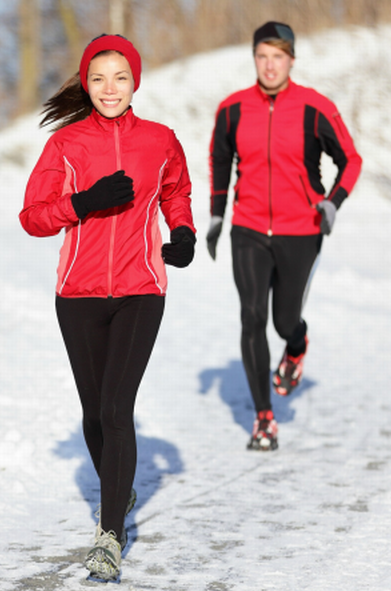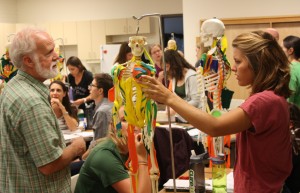Study: What causes blood vessels to expand during exercise?
A CSU researcher has teamed up with the Mayo Clinic to pin down what causes blood vessels to expand and contract during exercise.
A CSU researcher has teamed up with the Mayo Clinic to pin down what causes blood vessels to expand and contract during exercise.
This article was written by CK Kemp and Amy Quinn, Ph.D. students the Department of Human Development and Family Studies.
The holidays are a fun time of celebration and meeting with loved ones. But they can also be times of remembrance, sadness, and stress. Depressive feelings and signs can pop up during the holidays because of this. Also, our bodies are finally able to relax from school and work during winter break, which means that signs of depression that were kept hidden during the semester are finally showing up.
Here are some good strategies for self-care to lessen the holiday blues! Take a break over winter break
The holidays are often full of gatherings and events. It is easy to get swept away by dinner parties and gift exchanges, and miss out on meaningful rest and down-time. When planning the holiday calendar this year, try blocking out a few personal "dates" for a little R&R. It can be anything from taking the afternoon to read, getting a massage, or just catching up on sleep. Taking more time to rest makes people feel rejuvenated, and that way they can better enjoy time with friends and family.
No date to the office party? No problem!
If friends and family live far away, the holidays can feel lonely or isolating. For some people, alone time can exacerbate sad or depressive feelings. The holidays can be a great time to meet new people, as there are many events, shows, and celebrations throughout the holiday season. Decide to attend a party or gathering alone and meet at least one new person – other people are looking for new friends too!
Adopt a kind state of mind
Although there are lots of joyous aspects to the holiday season, it is also common for difficulties to arise such as missing loved ones, feeling stressed about money, or having conflict with visiting family members. In these moments, it can be easy to become self-critical or critical of others. It’s impossible to avoid negativity completely, but try working towards positivity by showing gratitude and being present during interactions. Check out Mindfully Managing Stress workshops at CSU, or look up gratitude practices online before the holidays begin!
Eat well and exercise
Let's face it - everyone tends to overindulge during the winter season. Just try and keep a balance of these indulgences. Counteract calories from holiday parties by planning workout days. Ate or drank too much at one party? Then try and limit sweets and drinks at the next. When looking at all of the delicious foods at a holiday event, fill the plate with veggies first and then just pick one or two desserts.
To talk further about depression or depressive feelings, contact these great resources:
Take a break over winter break
The holidays are often full of gatherings and events. It is easy to get swept away by dinner parties and gift exchanges, and miss out on meaningful rest and down-time. When planning the holiday calendar this year, try blocking out a few personal "dates" for a little R&R. It can be anything from taking the afternoon to read, getting a massage, or just catching up on sleep. Taking more time to rest makes people feel rejuvenated, and that way they can better enjoy time with friends and family.
No date to the office party? No problem!
If friends and family live far away, the holidays can feel lonely or isolating. For some people, alone time can exacerbate sad or depressive feelings. The holidays can be a great time to meet new people, as there are many events, shows, and celebrations throughout the holiday season. Decide to attend a party or gathering alone and meet at least one new person – other people are looking for new friends too!
Adopt a kind state of mind
Although there are lots of joyous aspects to the holiday season, it is also common for difficulties to arise such as missing loved ones, feeling stressed about money, or having conflict with visiting family members. In these moments, it can be easy to become self-critical or critical of others. It’s impossible to avoid negativity completely, but try working towards positivity by showing gratitude and being present during interactions. Check out Mindfully Managing Stress workshops at CSU, or look up gratitude practices online before the holidays begin!
Eat well and exercise
Let's face it - everyone tends to overindulge during the winter season. Just try and keep a balance of these indulgences. Counteract calories from holiday parties by planning workout days. Ate or drank too much at one party? Then try and limit sweets and drinks at the next. When looking at all of the delicious foods at a holiday event, fill the plate with veggies first and then just pick one or two desserts.
To talk further about depression or depressive feelings, contact these great resources:
The following article was written by Kimberly Burke, director of the Adult Fitness Program at CSU. As another beautiful fall season unwinds there are some ways to take advantage of the fall without feeling the effects of the approaching winter. Many people transition to outdoor exercises over the summer months, and then slowly retreat back indoors. But exercising outdoors does not have to be hindered by cold weather. Here are a few simple ways to stay warm out in the cold.
Always warm up
It is important to avoid sudden exertion by going through a proper warm-up. In colder weather muscles will take longer to warm up, so warming up an extra 5-10 minutes is encouraged. Properly warmed muscles will help to prevent injury and enables longer exercise.
It's OK to decrease intensity
When temperatures drop the body responds by constricting its arteries to keep the core temperature higher. In doing so the heart has to work harder to pump blood through a narrower space, adding to the extra load created by exercising. So don't be surprised if running as long or hard in colder weather is difficult. Don’t worry; every workout does not have to be a marathon.
Wear layers
Easy removal and addition of clothing is key; aim for wearing layers that can be zipped/unzipped quickly. That way there’s no need to stop in the middle of a workout and it allows the body to better adjust to temperature changes. Always make sure to have a hat and scarf, because as much as 40 percent of body heat is lost through the head. Just as importantly, keep hands and feet properly covered to prevent heat loss. Pay attention to the forecast to not be caught in unexpected weather.
Avoid alcoholic beverages
Winter months can bring about some great brews and they're hard to pass up in Fort Collins, but it is best to avoid them prior to a workout. The initial sensation of warmth from drinking alcohol is from blood vessels on the skins surface dilating. This in turn causes warmth to be drawn away from vital organs, which during cold weather is not ideal. It is the complete opposite of the body's natural instincts and feedback responses.
Stay hydrated and wear sunscreen
It is always important to stay hydrated, even when it is cold outside. It’s important to know that thirst doesn’t mean you’re dehydrated. Thirst is actually a delayed response to dehydration, and dehydration is often harder to catch in cold weather. Be sure to drink plenty of water before, during and after a workout. Don't forget the sunscreen; getting sunburned isn't just for the summer, especially since Fort Collins is nearly a mile high. Look for sunblock that provides UVA/UVB protection and keep those sunglasses handy.
CSU's Adult Fitness Program offers exercise opportunities for employees of CSU as well as community members, while providing hands-on learning experiences for health promotion students.
As another beautiful fall season unwinds there are some ways to take advantage of the fall without feeling the effects of the approaching winter. Many people transition to outdoor exercises over the summer months, and then slowly retreat back indoors. But exercising outdoors does not have to be hindered by cold weather. Here are a few simple ways to stay warm out in the cold.
Always warm up
It is important to avoid sudden exertion by going through a proper warm-up. In colder weather muscles will take longer to warm up, so warming up an extra 5-10 minutes is encouraged. Properly warmed muscles will help to prevent injury and enables longer exercise.
It's OK to decrease intensity
When temperatures drop the body responds by constricting its arteries to keep the core temperature higher. In doing so the heart has to work harder to pump blood through a narrower space, adding to the extra load created by exercising. So don't be surprised if running as long or hard in colder weather is difficult. Don’t worry; every workout does not have to be a marathon.
Wear layers
Easy removal and addition of clothing is key; aim for wearing layers that can be zipped/unzipped quickly. That way there’s no need to stop in the middle of a workout and it allows the body to better adjust to temperature changes. Always make sure to have a hat and scarf, because as much as 40 percent of body heat is lost through the head. Just as importantly, keep hands and feet properly covered to prevent heat loss. Pay attention to the forecast to not be caught in unexpected weather.
Avoid alcoholic beverages
Winter months can bring about some great brews and they're hard to pass up in Fort Collins, but it is best to avoid them prior to a workout. The initial sensation of warmth from drinking alcohol is from blood vessels on the skins surface dilating. This in turn causes warmth to be drawn away from vital organs, which during cold weather is not ideal. It is the complete opposite of the body's natural instincts and feedback responses.
Stay hydrated and wear sunscreen
It is always important to stay hydrated, even when it is cold outside. It’s important to know that thirst doesn’t mean you’re dehydrated. Thirst is actually a delayed response to dehydration, and dehydration is often harder to catch in cold weather. Be sure to drink plenty of water before, during and after a workout. Don't forget the sunscreen; getting sunburned isn't just for the summer, especially since Fort Collins is nearly a mile high. Look for sunblock that provides UVA/UVB protection and keep those sunglasses handy.
CSU's Adult Fitness Program offers exercise opportunities for employees of CSU as well as community members, while providing hands-on learning experiences for health promotion students.
CSU student parents with children enrolled at the Early Childhood Center rode on a float pulled by a truck driven by President Frank in the CSU Homecoming parade on Oct. 17.
Dr. Karen Atler, an assistant professor in the Colorado State University Department of Occupational Therapy, recently received the 2014 Marjorie Ball Award of Merit at the Occupational Therapy Association of Colorado State Conference.
 The following column was written by Melissa Wdowik, PhD, RDN, an assistant professor at Colorado State University in the Department of Food Science and Human Nutrition, and director of the Kendall Anderson Nutrition Center.
Genetically engineered foods are all around us: an estimated 60 percent to 80 percent of processed foods in U.S. grocery stores have genetically modified ingredients. With the food labeling initiative Proposition 105 on the November ballot, this is a good time to improve our understanding of both genetic engineering and the voting option before us.
Genetic engineering involves the transfer of genes for particular traits between species. Other terms for genetically engineered (GE) plants (or foods derived from them) are genetically modified (GM), genetically modified organism (GMO), and bioengineered. Historically, most of our foods have been naturally genetically modified through domestication of wild plants and natural selection, and agriculturally modified using genetic and selective breeding. The newer techniques of bioengineering are more precise laboratory methods of physically removing a gene from one organism and adding it into another, giving it the ability to express a desired trait. Most current GM crops have been engineered for resistance to insects, diseases, or herbicides. While “herbicide tolerance” sounds like an excuse to use more herbicides, it actually allows farmers to use products that are more environmentally friendly, while reducing soil erosion and CO2 emissions.
According to Dr. Patrick Byrne, a professor in CSU’s Department of Soil and Crop Sciences, crops most commonly engineered in Colorado include corn, alfalfa, and sugar beets, as well as soybeans and canola. Nationwide, cotton is another major engineered crop.
The biggest concern to consumers is: are these GM crops safe to eat? The term “frankenfood” was coined to reflect fears of unknown changes to our food supply. Indeed there are both pros and cons to genetically engineered foods espoused by supporters and detractors, respectively.
Supporters say benefits include increased pest and disease resistance, drought tolerance, and increased yields. They point to 18 years of GM consumption and hundreds of research studies finding no difference in food safety or nutritional value between GM and non-GM foods. They also point to potential GM crops that are nutritionally superior, such as Golden Rice, enriched with beta-carotene.
Detractors say risks include creation of pesticide-resistant weeds, accidental contamination between GM and non-GM crops and, hypothetically at least, antibiotic resistance and introduction of allergens into foods. The issues go further, however, with political, environmental and industrial arguments beyond the scope of this column. It is a highly complex issue, full of pros and cons.
The question remains, will labeling of GMOs help? Food labeling may give transparency for consumers to make informed decisions, but critics remind us that the cost will be passed on to taxpayers and consumers and loopholes make the benefits questionable: many foods will be exempt even when they do contain GE ingredients. Some experts support labels but want to wait for more accurate, reliable labeling rules. In the meantime, interested consumers can buy certified organic foods, which are by law free of GE ingredients, or “Non-GMO Verified” products. See Dr. Byrne’s thorough, unbiased explanation of labeling pros and cons here.
A related SOURCE story on this ballot measure, "Researcher: Analysis of GMO labeling initiative unbiased," is available here.
The following column was written by Melissa Wdowik, PhD, RDN, an assistant professor at Colorado State University in the Department of Food Science and Human Nutrition, and director of the Kendall Anderson Nutrition Center.
Genetically engineered foods are all around us: an estimated 60 percent to 80 percent of processed foods in U.S. grocery stores have genetically modified ingredients. With the food labeling initiative Proposition 105 on the November ballot, this is a good time to improve our understanding of both genetic engineering and the voting option before us.
Genetic engineering involves the transfer of genes for particular traits between species. Other terms for genetically engineered (GE) plants (or foods derived from them) are genetically modified (GM), genetically modified organism (GMO), and bioengineered. Historically, most of our foods have been naturally genetically modified through domestication of wild plants and natural selection, and agriculturally modified using genetic and selective breeding. The newer techniques of bioengineering are more precise laboratory methods of physically removing a gene from one organism and adding it into another, giving it the ability to express a desired trait. Most current GM crops have been engineered for resistance to insects, diseases, or herbicides. While “herbicide tolerance” sounds like an excuse to use more herbicides, it actually allows farmers to use products that are more environmentally friendly, while reducing soil erosion and CO2 emissions.
According to Dr. Patrick Byrne, a professor in CSU’s Department of Soil and Crop Sciences, crops most commonly engineered in Colorado include corn, alfalfa, and sugar beets, as well as soybeans and canola. Nationwide, cotton is another major engineered crop.
The biggest concern to consumers is: are these GM crops safe to eat? The term “frankenfood” was coined to reflect fears of unknown changes to our food supply. Indeed there are both pros and cons to genetically engineered foods espoused by supporters and detractors, respectively.
Supporters say benefits include increased pest and disease resistance, drought tolerance, and increased yields. They point to 18 years of GM consumption and hundreds of research studies finding no difference in food safety or nutritional value between GM and non-GM foods. They also point to potential GM crops that are nutritionally superior, such as Golden Rice, enriched with beta-carotene.
Detractors say risks include creation of pesticide-resistant weeds, accidental contamination between GM and non-GM crops and, hypothetically at least, antibiotic resistance and introduction of allergens into foods. The issues go further, however, with political, environmental and industrial arguments beyond the scope of this column. It is a highly complex issue, full of pros and cons.
The question remains, will labeling of GMOs help? Food labeling may give transparency for consumers to make informed decisions, but critics remind us that the cost will be passed on to taxpayers and consumers and loopholes make the benefits questionable: many foods will be exempt even when they do contain GE ingredients. Some experts support labels but want to wait for more accurate, reliable labeling rules. In the meantime, interested consumers can buy certified organic foods, which are by law free of GE ingredients, or “Non-GMO Verified” products. See Dr. Byrne’s thorough, unbiased explanation of labeling pros and cons here.
A related SOURCE story on this ballot measure, "Researcher: Analysis of GMO labeling initiative unbiased," is available here.
[caption id="attachment_5340" align="alignright" width="300"] An occupational therapy class during the 2014 summer session.[/caption]
Current and former students have voted Colorado State University's Department of Occupational Therapy as the best in the country — again.
In the latest rankings by GraduatePrograms.com, CSU’s occupational therapy program beat out OT departments at Washington University in St. Louis (2nd), Boston University (9th), Columbia University (12th) and the University of Southern California (20th) for the top spot.
“We are honored to be ranked as the number one occupational therapy department in the nation,” said Robert Gotshall, interim head of the department. “Our students and alumni rank us through Graduateprograms.com, and this is the second year in a row that we have topped the list of 25 best occupational therapy programs in the nation. Now it is the responsibility of our faculty to maintain the educational quality that has inspired our students to rank us so highly.”
The professional program in the Department of Occupational Therapy — part of the College of Health and Human Sciences — long has been recognized as one of the nation's best. U.S. News and World Report ranked the program No. 6 in the country in its 2014 survey.
Graduateprograms.com reaches current and recent graduate students through scholarship entries as well as social media platforms. The program rankings cover a period from Sept. 1, 2012 to Sept. 30, 2014. Graduateprograms.com assigns 15 ranking categories to each graduate program at each graduate school. Rankings cover a variety of student topics, such as academic competitiveness, career support, financial aid, and quality of network. For a given graduate program, rankings are determined by calculating the average score for each program based on the 15 ranking categories.
More information is available at www.graduateprograms.com/top-occupational-therapy.
An occupational therapy class during the 2014 summer session.[/caption]
Current and former students have voted Colorado State University's Department of Occupational Therapy as the best in the country — again.
In the latest rankings by GraduatePrograms.com, CSU’s occupational therapy program beat out OT departments at Washington University in St. Louis (2nd), Boston University (9th), Columbia University (12th) and the University of Southern California (20th) for the top spot.
“We are honored to be ranked as the number one occupational therapy department in the nation,” said Robert Gotshall, interim head of the department. “Our students and alumni rank us through Graduateprograms.com, and this is the second year in a row that we have topped the list of 25 best occupational therapy programs in the nation. Now it is the responsibility of our faculty to maintain the educational quality that has inspired our students to rank us so highly.”
The professional program in the Department of Occupational Therapy — part of the College of Health and Human Sciences — long has been recognized as one of the nation's best. U.S. News and World Report ranked the program No. 6 in the country in its 2014 survey.
Graduateprograms.com reaches current and recent graduate students through scholarship entries as well as social media platforms. The program rankings cover a period from Sept. 1, 2012 to Sept. 30, 2014. Graduateprograms.com assigns 15 ranking categories to each graduate program at each graduate school. Rankings cover a variety of student topics, such as academic competitiveness, career support, financial aid, and quality of network. For a given graduate program, rankings are determined by calculating the average score for each program based on the 15 ranking categories.
More information is available at www.graduateprograms.com/top-occupational-therapy.
Colorado State University’s Fashion Group International student chapter will be hosting its annual recycled fall fashion show on Nov. 15 between 7 and 9 p.m. in the Ballroom of the Lory Student Center on CSU’s campus.
The Department of Design and Merchandising has received its first swatch of funding from revenues generated by the Tartan Plaid one of its students designed last year.
Brad Sheafor, professor emeritus of the School of Social Work at Colorado State University, has recently had the 10th edition of his popular textbook Techniques and Guidelines for Social Work Practice published by Pearson Education, with Charles R. Horejsi as co-author.